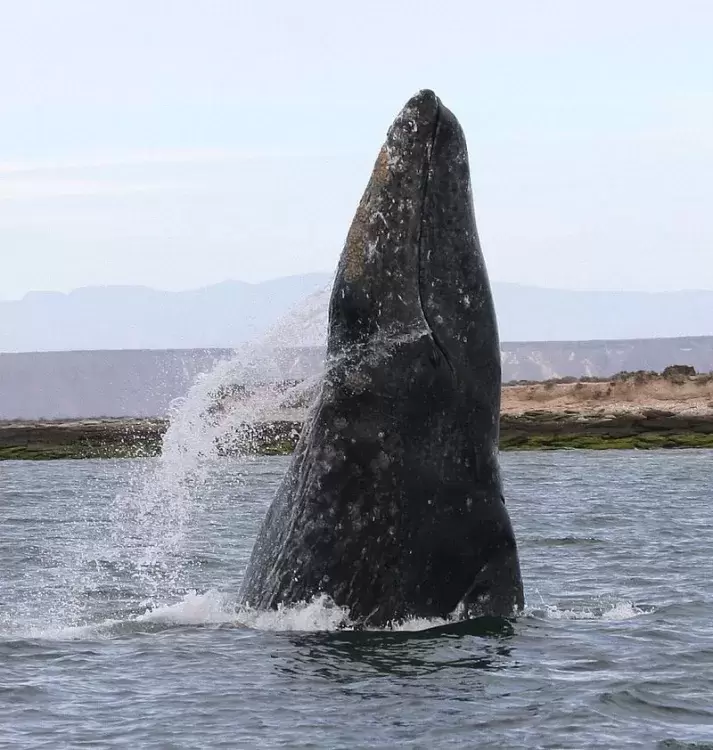Discovery of a grey whale carcass on the shore of Haida Gwaii is the latest among more than 40 reported deaths during the cetacean’s annual West Coast migration.
A DFO team was headed to the archipelago Thursday to conduct a necropsy on the eastern Pacific grey, said Paul Cottrell, Pacific Region marine mammal response co-ordinator.
“This is No. 3 in the last month,” Cottrell said, referring only to reports in B.C. waters. “And we’ve been able to secure necropsy results for all three.”
To date, more than 40 eastern Pacific grey whales, many of them emaciated, have washed ashore during their annual migration from the Mexican Baja to summer feeding grounds in southeast Alaska. While the phenomenon is not unprecedented — a similar die-off among migrating greys occurred about a decade ago — marine mammal specialists in Canada and the United States are working together to solve the mystery.
“We’ve got concerns that we’re going to get more,” Cottrell said. “We’re definitely on high alert.”
DFO is awaiting DNA results from the first two necropsies to determine cause of death. Cottrell was able to confirm that both animals were emaciated — their body condition was very poor — similar to many reports from the U.S. Until more conclusive analysis can be done, it’s difficult to guess what may be behind the large number of fatalities.
“There are a lot of potential reasons why,” he said. “That’s why we’re doing as much as we can to hopefully determine what’s going on.”
He urged people to report sightings of dead whales to DFO’s Marine Mammal Hotline, 1-800-465-4336.
Eastern gray whales have long been considered one of the success stories among large cetaceans, their population rebounding to 20,000 animals or more after whaling was banned in 1986. Their numbers were considered strong this season, which is consistent with sighting reports along the coast of B.C.
About 250 greys, known as the Pacific feeding group, inhabit the B.C. coast through the summer. Grey whale migration draws thousands of sightseers to the West Coast at this time of year.
John Ford, who operates The Whale Centre, a Tofino-based tour company, has seen similar trends during his 30 years in the business.
“We see this cyclically,” Ford said. “I think it was in 2008 we had a pretty high die-off. Basically, it’s like penguins or large migratory birds. All the animals don’t get enough food.”
In the case of grey whales, which travel the longest migration of any mammal, the feeding requirements are naturally extreme. Daily, they consume roughly 1,100 kilograms of mostly amphipod crustaceans and store the fat for their long journeys south to breeding lagoons in the Baja.
In Alaskan waters, benthic life (including microorganisms and crustaceans) drops from melting sea ice to settle on the ocean floor, where the whales filter-feed using their baleen plates. One theory suggests that bottom feeding was limited last summer by prolonged ice cover.
For the sub-group of B.C. summer-resident grey whales, there could be other issues relating to feed. Another possibility is that the population has reached its maximum carrying capacity.
“All kinds of factors are involved,” Ford said. “Around here, over the last two years we’re seeing a lot less mycetes,” which are fungal blooms on which the greys feed.
“We haven’t seen a lot of that in the last couple years,” he added. “Two years in a row, it starts to raise concerns.”
As the migration period continues, a significant number of greys have been reported, Cottrell said. A number has amassed in the shallow waters off Boundary Bay south of Vancouver, including a mother-and-calf pair that was briefly stranded Saturday, May 11 before being freed, and in Cordova Bay. Other reports have come from the West Coast, he noted.
Meanwhile, the U.S. National Ocean and Atmospheric Administration (NOAA) is expected to announce the grey whale fatalities as an “unusual mortality event.” Assigned in cases where significant numbers of marine mammal deaths occur, the status requires an immediate response on the understanding that it may signal a problem with ocean health.
Grey whales, together with humpback whales, were a vital resource for Nuu-chah-nulth and Makah peoples along the west coast before commercial whaling reduced numbers to about 10 per cent of the current population. Greys, faster, leaner and more dangerous than humpbacks, were evidently not as favoured by Indigenous whalers.
“Nuu-chah-nulth oral narratives tell of hunters taking these whales while they were ‘standing on their heads’ near shore, their tails showing above the water while they scooped molluscs off the bottom,” writes SFU archeologist Alan McMillan in the article Nuu-chah-nulth Whales and Whalers.
Tseshaht, Toquaht and Huu-ay-aht nations worked with McMillan over a 20-year period, helping to reveal the archeological record of what he terms the “whaling complex.”







